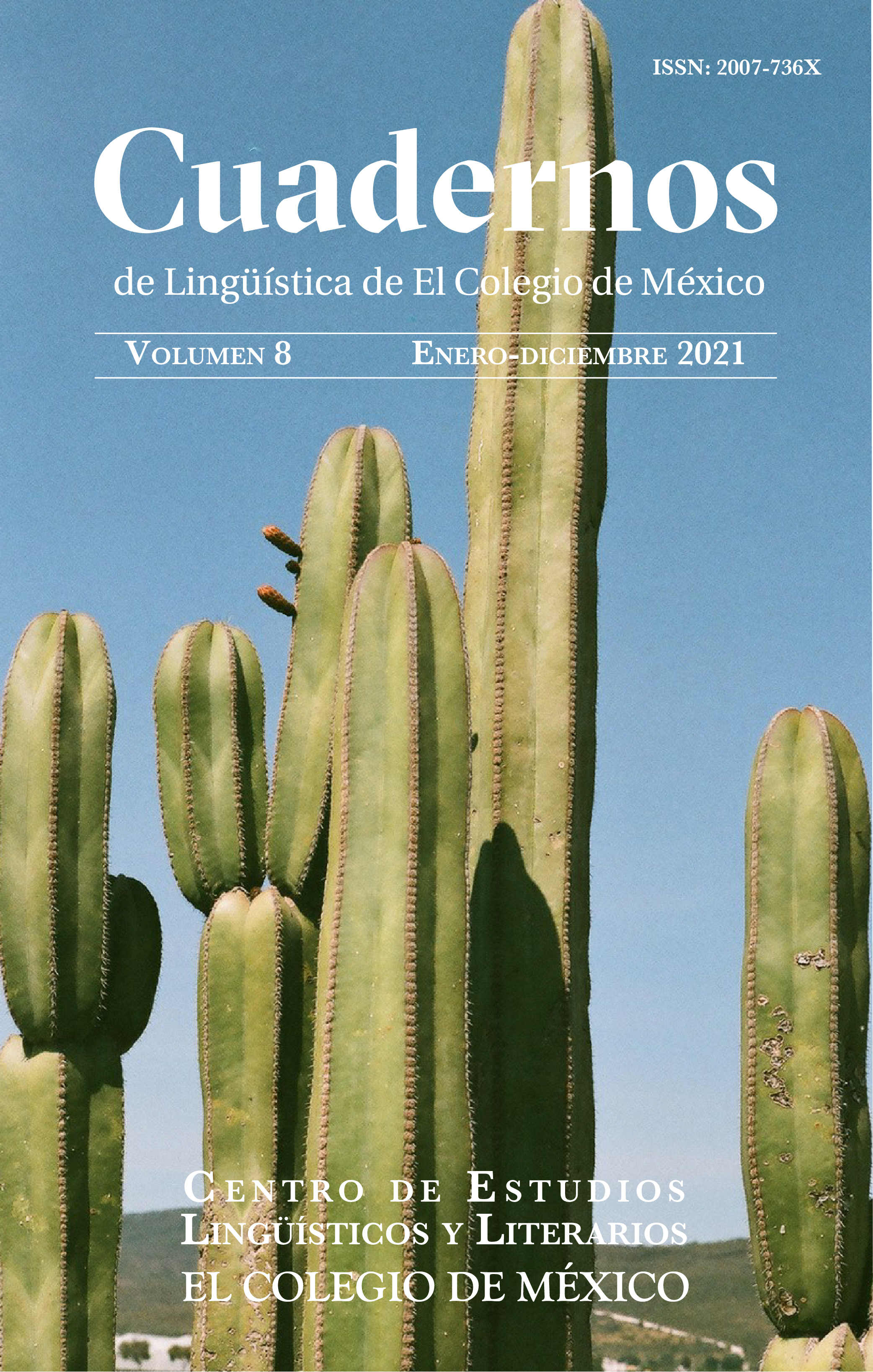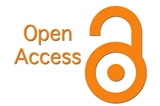Phonological word in Miahuatec
DOI:
https://doi.org/10.24201/clecm.v8i0.239Keywords:
phonology, southern zapotec, stress, phonological wordAbstract
Miahuatec is a prominently monosyllabic Zapotec language that has a iambic (W.S) pattern and right-to-left directionality. The most prominent stress cue is the duration of the rhyme –obligatorily bimoraic– but the intensity and the formantic stability serve as phonetic reinforcements of stress. In this language, there are phonemic processes –as fortition, laryngeal and tonal simplification–that accomplish a demarcative function at phonological word level.
Downloads
References
Antonio, Pafnuncio. 2015. La fonología y morfología del zapoteco de San Pedro Mixtepec. México: Centro de Investigaciones y Estudios Superiores en Antropología Social. (Tesis doctoral).
Arellanes, Francisco. 2009. El sistema fonológico y las propiedades fonéticas del zapoteco de San Pablo Güilá: Descripción y análisis formal. México: El Colegio de México. (Tesis doctoral).
Clements, George & Keyser, Samuel. 1983. CV Phonology: A generative theory of the syllable. Cambridge, Massachussets: MIT Press.
Chávez Peón, Mario E. 2010. The interaction of metrical structure, tone and phonation types in Quiaviní Zapotec. Vancouver: The University of British Columbia. (Tesis doctoral).
Chávez Peón, Mario E. En Prensa. Entre prosodia tono y voz. Correlatos acústicos del acento en el zapoteco de San Lucas Quiaviní. Memorias del 3er Coloquio de Lenguas Otomangues y Vecinas María Teresa Fernández de Miranda. 2008, Oaxaca, México.
Dressler, Wolfgang. 2006. Compound types. En Libben, Gary & Jarena, Gonia (eds.), The representation and processing of compound words, 23–44. Oxford: Oxford University Press.
Flanagan, James. 1955. Processing redundant information. The Journal of the Acoustical Society of America 27. 1223–1225.
Giancoli, D. C., & Campos Olguín, V. 2006. Física: principios con aplicaciones. Volumen 1. México: Pearson Educación.
Gordon, Matthew & Roettger, T. 2017. Acoustic correlates of word stress: A cross-linguistic survey. Linguistics Vanguard 3(1). 20170007. https://doi.org/10.1515/lingvan-2017-0007.
Herrera Zendejas, Esther. 2014. Mapa fónico de las lenguas mexicanas. Formas sonoras 1 y 2. México: El Colegio de México.
Hernández Luna, Mario Ulises. 2021. Acento y legitimación del rasgo [glotis constreñida] en miahuateco. Lingüística mexicana, Nueva época 3(1). 151–171.
Hernández Luna, Mario Ulises. 2019. Fonología del miahuateco: sincronía, diacronía y clasificación. México: El Colegio de México. (Tesis doctoral).
Hayes, Bruce. 1987. A revised parametric metrical theory, Papers from the Annual Meeting of the North East Linguistic Society 17. 274–289.
Hayes, Bruce. 1995. Metrical stress theory: Principles and case studies. Chicago: University of Chicago Press.
Hyman, Larry. 2006. Word-prosodic typology. Phonology 23(2). 225–257.
Hyman, L. M. 2014. Do all languages have word accent? En van der Hulst, Harry (ed.), Word stress: Theoretical and typological issues, 56–82. Cambridge: Cambridge University Press.
Kager, René. 1999. Optimality theory, Cambridge: Cambridge University Press.
Kaufman, Terrence. 2015. A typologically odd reconstruction for proto-Sapotekan steam-final *k. Manuscrito recuperado de: https://www.albany.edu/ims/pdlma/2015%20Publications/Kaufman-protoSapotekan%20stemfinal%20k-a%20typologically%20odd%20reconstruction-revd2015.pdf
López Nicolás, Óscar. 2016. Estudios de la fonología y gramática del zapoteco de Zoochina. México: Centro de Investigaciones y Estudios Superiores en Antropología Social. (Tesis doctoral).
McCarthy, John & Prince, Alan. 1986. Prosodic morphology. (Linguistics Department Faculty Publication Series 13). Recuperado de https://scholarworks.umass.edu/linguist_faculty_pubs/13.
Nespor, Marina & Vogel, Irene. [1986] 1997. Prosodic phonology. Berlín: De Gruyter Mouton.
Nishinuma, Yukihiro; di Cristo, Albert & Espesser, Robert. 1983. Loudness as a function of vowel duration in CV syllables. Speech communication 2. North-Holland. 167–169.
Prince, Alan & Smolensky, Paul. 2004. Optimality theory: Constraint interaction in generative grammar. Oxford: Blackwell. [Ms. Rutgers University and University of Colorado, Boulder, 1993]
Selkirk, Elisabeth. 1982. The syllable. En van der Hulst, Harry & Smith, N. (eds.), The structure of phonological representations. Vol. 2, 337–383. Dordrecht: Foris.
Sicoli, Mark 2007. Tono: A linguistic ethnography of tone and voice in a Zapotec region. The Michigan: University of Michigan. (Tesis doctoral).
Smith-Stark, Thomas. 2007. Algunas isoglosas zapotecas. En Buenrostro, Cristina et al. (eds.), Clasificación de las lenguasindígenas de México. Memorias del III Coloquio internacional de lingüística Mauricio Swadesh. 69–133. México: Instituto de Investigaciones Antropológicas de la Universidad Nacional Autónoma de México/Instituto Nacional de Lenguas Indígenas.
Trubetzkoy, Nikolai. 2019. [1939]. Principios de fonología. Nueva traducción y edición crítica. Herrera, Esther & Knapp, Michael (eds.), México: El Colegio de México.
Turk, A. E., & Sawusch, J. R. 1996. The processing of duration and intensity cues to prominence. The Journal of the Acoustical Society of America 99(6). 3782–3790.
van der Hulst, Harry; Rice, Karen & Wetzels, Leo. 2010. The languages of middle America. En van der Hulst, Harry; Goedemans, Rob & van Zanten, Ellen (eds.), A survey of word accentual patterns, 313– 80. Berlín: Walter de Gruyter.
Published
How to Cite
-
Abstract866
-
PDF (Español)344
-
XML (Español)40
-
EPUB (Español)66
-
Kindle (Español)72
-
MP3 (Español)15
Issue
Section
License
Copyright (c) 2021 Mario Hernández Luna

This work is licensed under a Creative Commons Attribution-NonCommercial-NoDerivatives 4.0 International License.
Authors retain copyright of their work and are free to disseminate it, make copies for any use, and/or deposit in any repository or archive of their choice, but they grant Cuadernos de Lingüística de El Colegio de México the right to publish the work for the first time. Authors agree to acknowledge Cuadernos de Lingüística de El Colegio de México as the site of original publication of their article / note / review through proper citation.
Articles appearing in Cuadernos de Lingüística de El Colegio de México are made available to readers under a Attribution-NonCommercial-NoDerivatives 4.0 International.









